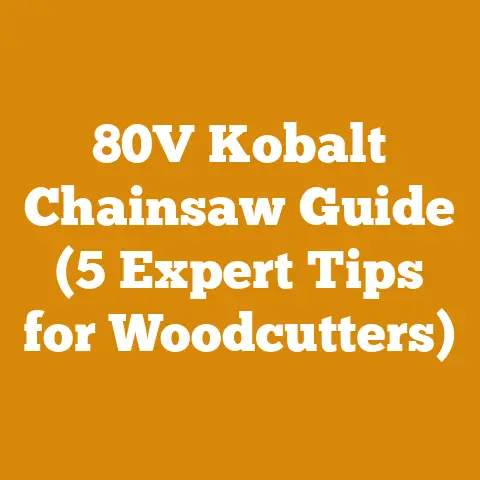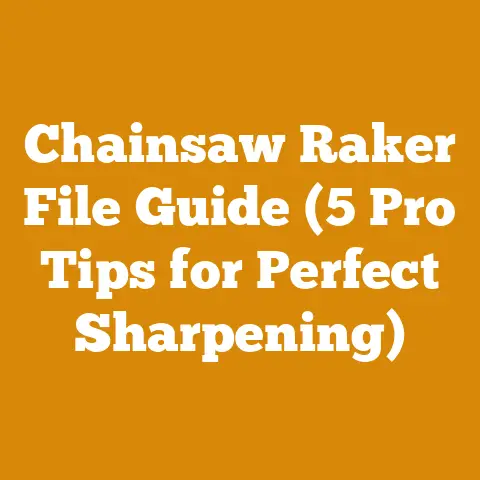455 Rancher Sprocket Guide (5 Expert Tips for Optimal Cutting)
Let’s bust a common myth right off the bat: that a chainsaw’s sprocket is just a simple, unchanging part. It’s not! The sprocket, especially on a workhorse like the Husqvarna 455 Rancher, is a crucial component that directly impacts cutting performance and chain life. Choosing the right sprocket and maintaining it properly can make a world of difference. I’ve seen firsthand how a worn or incorrect sprocket can turn a smooth operation into a frustrating, time-consuming mess. So, let’s dive into the world of 455 Rancher sprockets and unlock the secrets to optimal cutting.
455 Rancher Sprocket Guide: 5 Expert Tips for Optimal Cutting
My journey with chainsaws started young, helping my grandfather clear fallen trees on his property. The 455 Rancher was his favorite, and through him, I learned the importance of every part, including the often-overlooked sprocket. These tips aren’t just theoretical; they’re born from years of practical experience.
Understanding the Importance of Your 455 Rancher Sprocket
The sprocket is the unsung hero, the link between the chainsaw’s engine and the cutting chain. It transfers power, driving the chain around the bar to slice through wood. A worn or damaged sprocket reduces cutting efficiency, increases chain wear, and can even damage the engine.
- Power Transfer: The sprocket’s teeth engage with the chain, pulling it along the bar.
- Chain Speed: Influences how quickly and cleanly the saw cuts.
- Wear and Tear: A worn sprocket accelerates chain wear, requiring more frequent replacements.
Think of it like the gears on a bicycle. If the gears are worn, you’ll struggle to pedal efficiently, and the chain might slip. The same principle applies to your chainsaw.
Tip #1: Identifying the Correct Sprocket Type for Your Needs
Not all sprockets are created equal. The 455 Rancher typically uses a standard .325″ pitch sprocket, but variations exist. The pitch refers to the distance between the drive links on your chain. Using the wrong pitch sprocket will cause the chain to bind or slip, rendering the saw useless.
- .325″ Pitch: The most common type for the 455 Rancher, suitable for general cutting.
- 3/8″ Pitch: Less common on the 455 Rancher but can be used with a compatible chain and bar for heavier tasks.
- Rim Sprocket vs. Spur Sprocket: Rim sprockets are replaceable, offering cost savings. Spur sprockets are a single unit and usually more durable.
Choosing the Right Sprocket:
- Check your chain: The pitch is usually stamped on the drive links.
- Consult your owner’s manual: It specifies the recommended sprocket types.
- Consider your cutting needs: For occasional use, a standard .325″ rim sprocket is fine. For heavy-duty work, a spur sprocket might be a better choice.
I once tried to use a 3/8″ pitch chain on a .325″ sprocket. The result? A jammed chain, a frustrated afternoon, and a valuable lesson learned. Always double-check compatibility!
Tip #2: Recognizing the Signs of a Worn Sprocket
A worn sprocket doesn’t just affect cutting performance; it can also damage your chain and bar. Regular inspection is key to preventing costly repairs.
- Visible Wear: Look for rounded or chipped teeth. Sharp, well-defined teeth are essential for proper chain engagement.
- Chain Slippage: If the chain frequently slips or jumps off the bar, the sprocket might be worn.
- Increased Vibration: Excessive vibration can indicate a worn sprocket or other mechanical issues.
- Uneven Chain Wear: A worn sprocket can cause the chain to wear unevenly, shortening its lifespan.
The Coin Test:
A simple way to check for wear is the “coin test.” Place a coin (a dime or penny works well) against the sprocket teeth. If the teeth are significantly shorter than the coin’s edge, it’s time to replace the sprocket.
I remember a time when I ignored the early signs of a worn sprocket. The chain kept slipping, and I just kept tightening it. Eventually, the chain snapped, and I had to replace both the chain and the sprocket. Lesson learned: address the problem early!
Tip #3: Step-by-Step Sprocket Replacement Guide
Replacing a sprocket is a relatively straightforward process, but it requires the right tools and a bit of patience. Always disconnect the spark plug wire before starting any repairs to prevent accidental starting.
Tools You’ll Need:
- Scrench (combination screwdriver and spark plug wrench)
- Socket wrench set
- Piston stop tool (optional, but recommended)
- New sprocket
- Grease
Step-by-Step Instructions:
- Remove the chain and bar: Loosen the bar nuts and remove the chain and bar.
- Remove the clutch cover: Use the scrench to remove the clutch cover.
- Secure the piston: Insert the piston stop tool into the spark plug hole to prevent the piston from moving. If you don’t have a piston stop tool, you can carefully feed a length of rope into the cylinder through the spark plug hole. Be gentle!
- Remove the clutch: Use the socket wrench to remove the clutch nut. The clutch is usually reverse-threaded, so turn it clockwise to loosen it.
- Remove the old sprocket: Depending on whether it’s a rim or spur sprocket, it will either slide off the clutch drum or be integrated with the clutch drum.
- Install the new sprocket: If it’s a rim sprocket, slide it onto the clutch drum. If it’s a spur sprocket, you’ll need to replace the entire clutch drum assembly.
- Reinstall the clutch: Tighten the clutch nut counter-clockwise (remember, it’s reverse-threaded). Use the piston stop tool to prevent the engine from turning.
- Remove the piston stop tool: Remove the tool or rope from the spark plug hole.
- Reinstall the clutch cover, bar, and chain: Make sure the chain is properly tensioned.
- Test the saw: Start the saw and check for smooth chain rotation.
Pro Tip: Apply a small amount of grease to the clutch bearing before reinstalling the clutch. This will help reduce friction and extend the life of the clutch.
I’ve replaced countless sprockets over the years, and I’ve learned that patience is key. Don’t rush the process, and double-check everything before starting the saw. A mistake here can lead to serious damage.
Tip #4: Maintaining Your Sprocket for Longevity
Proper maintenance can significantly extend the life of your sprocket and improve cutting performance.
- Regular Cleaning: Remove sawdust and debris from the sprocket area after each use.
- Greasing: Apply grease to the clutch bearing regularly.
- Chain Tension: Maintain proper chain tension. A loose chain can cause excessive wear on the sprocket.
- Sharp Chain: Use a sharp chain. A dull chain puts extra strain on the sprocket.
Chain Filing:
Learn to sharpen your own chains. A sharp chain cuts more efficiently and reduces stress on the sprocket and engine. Use a chain filing kit and follow the manufacturer’s instructions.
I always make it a habit to clean my chainsaw after each use, paying special attention to the sprocket area. It only takes a few minutes, but it can save you a lot of headaches down the road.
Tip #5: Troubleshooting Common Sprocket Problems
Even with proper maintenance, you might encounter problems with your sprocket. Here are some common issues and how to address them.
-
Chain Slippage:
- Cause: Worn sprocket, loose chain, dull chain.
- Solution: Replace the sprocket, adjust chain tension, sharpen the chain.
-
Chain Binding:
-
Cause: Incorrect sprocket pitch, damaged chain, insufficient lubrication.
- Solution: Use the correct sprocket and chain, inspect the chain for damage, ensure proper lubrication.
-
Excessive Vibration:
-
Cause: Worn sprocket, loose clutch, damaged clutch bearing.
- Solution: Replace the sprocket, tighten the clutch, replace the clutch bearing.
-
Sprocket Damage:
-
Cause: Impact with hard objects, improper chain tension, lack of lubrication.
- Solution: Avoid hitting rocks or other hard objects, maintain proper chain tension, ensure proper lubrication.
Case Study:
I once had a customer who complained of excessive vibration in his 455 Rancher. After inspecting the saw, I discovered that the clutch bearing was completely dry and the sprocket was worn. I replaced both the bearing and the sprocket, and the vibration disappeared. The problem was caused by a lack of lubrication.
Choosing the Right Replacement Sprocket
When it comes time to replace your sprocket, you have several options. You can choose an OEM (Original Equipment Manufacturer) sprocket, or an aftermarket sprocket.
- OEM Sprockets: These are made by Husqvarna and are designed to fit your 455 Rancher perfectly. They are generally more expensive than aftermarket sprockets, but they offer the best quality and reliability.
- Aftermarket Sprockets: These are made by third-party manufacturers and can be a more affordable option. However, the quality can vary, so it’s important to choose a reputable brand.
Factors to Consider:
- Price: Aftermarket sprockets are usually cheaper.
- Quality: OEM sprockets generally offer better quality and durability.
- Warranty: Some aftermarket sprockets come with a warranty.
- Reviews: Read online reviews to see what other users have to say about different brands.
I generally recommend using OEM sprockets for critical components like the sprocket. While they might cost more upfront, they will likely last longer and provide better performance in the long run.
Understanding Chain and Sprocket Compatibility
The chain and sprocket must be compatible for the chainsaw to function correctly. The pitch, gauge, and drive link count must match.
- Pitch: The distance between the chain’s drive links. Common pitches are .325″, 3/8″, and .404″.
- Gauge: The thickness of the drive links. Common gauges are .050″, .058″, and .063″.
- Drive Link Count: The number of drive links on the chain. This depends on the bar length.
Matching Chain and Sprocket:
- Check your bar: The bar usually has the pitch and gauge stamped on it.
- Consult your owner’s manual: It specifies the recommended chain and sprocket sizes.
- Use a chain gauge: A chain gauge can help you determine the pitch and gauge of your chain.
I’ve seen people try to use mismatched chains and sprockets, and it never ends well. The chain either binds, slips, or breaks. Always double-check compatibility before using your chainsaw.
Advanced Sprocket Considerations: Rim vs. Spur
As mentioned earlier, there are two main types of sprockets: rim sprockets and spur sprockets. Each has its own advantages and disadvantages.
- Rim Sprockets: These are replaceable rims that slide onto a clutch drum. They are more cost-effective to replace since you only need to replace the rim, not the entire clutch drum.
- Spur Sprockets: These are integrated with the clutch drum, forming a single unit. They are generally more durable and offer better power transfer, but they are more expensive to replace.
Choosing the Right Type:
- Rim Sprockets: Best for occasional use and cost-conscious users.
- Spur Sprockets: Best for heavy-duty use and users who prioritize durability and performance.
I prefer rim sprockets for my personal use because they are cheaper to replace. However, for professional loggers who use their chainsaws every day, spur sprockets might be a better choice.
The Impact of Sprocket Wear on Chain Health
A worn sprocket accelerates chain wear, reducing its lifespan and increasing the risk of breakage.
- Uneven Wear: A worn sprocket causes the chain to wear unevenly, leading to premature failure.
- Increased Friction: A worn sprocket increases friction between the chain and the bar, generating heat and causing wear.
- Chain Stretching: A worn sprocket can cause the chain to stretch, requiring more frequent tension adjustments.
Preventing Chain Wear:
- Replace the sprocket regularly: Replace the sprocket whenever it shows signs of wear.
- Maintain proper chain tension: A loose chain puts extra strain on the sprocket and chain.
- Use a sharp chain: A dull chain requires more force to cut, increasing stress on the sprocket and chain.
- Lubricate the chain properly: Proper lubrication reduces friction and wear.
I’ve found that replacing the sprocket and chain together as a set is a good practice. This ensures that both components are in good condition and work together optimally.
Lubrication’s Role in Sprocket and Chain Longevity
Proper lubrication is essential for reducing friction and wear on the sprocket and chain. Use a high-quality bar and chain oil and ensure that the oiler is functioning correctly.
- Reduces Friction: Lubrication reduces friction between the chain, sprocket, and bar.
- Dissipates Heat: Lubrication helps to dissipate heat, preventing overheating and wear.
- Removes Debris: Lubrication helps to flush away sawdust and debris, keeping the chain and sprocket clean.
Checking the Oiler:
- Start the saw: Start the saw and hold it over a piece of cardboard.
- Check for oil spray: You should see a steady stream of oil spraying from the bar.
- Adjust the oiler: If there is no oil spray, adjust the oiler screw until oil flows freely.
I always check the oiler before each use to make sure it’s working properly. A dry chain and sprocket will wear out quickly.
Safe Chainsaw Practices: Protecting Your Sprocket and Yourself
Safety should always be your top priority when using a chainsaw. Wear appropriate safety gear, including eye protection, hearing protection, gloves, and chaps.
- Eye Protection: Protect your eyes from flying debris.
- Hearing Protection: Protect your ears from the loud noise of the chainsaw.
- Gloves: Protect your hands from cuts and abrasions.
- Chaps: Protect your legs from accidental cuts.
Safe Cutting Techniques:
- Maintain a firm grip: Use both hands to control the chainsaw.
- Keep your feet firmly planted: Maintain a stable stance.
- Avoid cutting above your shoulder height: This is dangerous and can lead to loss of control.
- Be aware of your surroundings: Watch out for obstacles and other people.
I always wear full safety gear when using a chainsaw, no matter how small the job. It’s better to be safe than sorry.
The Future of Chainsaw Sprocket Technology
Chainsaw technology is constantly evolving, and sprockets are no exception. Manufacturers are developing new sprocket designs and materials to improve performance and durability.
- Advanced Materials: New materials, such as high-strength alloys and composites, are being used to make sprockets lighter and more durable.
- Improved Designs: New sprocket designs are being developed to improve power transfer and reduce wear.
- Smart Sprockets: Some manufacturers are even developing “smart” sprockets that can monitor wear and provide alerts when replacement is needed.
While these technologies are still in their early stages, they hold the promise of making chainsaws more efficient, reliable, and safe.
Final Thoughts: Mastering Your 455 Rancher Sprocket
The sprocket is a small but mighty component of your Husqvarna 455 Rancher. By understanding its importance, recognizing the signs of wear, and following these expert tips, you can ensure optimal cutting performance, extend chain life, and keep your chainsaw running smoothly for years to come. Remember, regular maintenance, proper lubrication, and safe operating practices are key to maximizing the life of your sprocket and your chainsaw. Now, go out there and make some sawdust!






